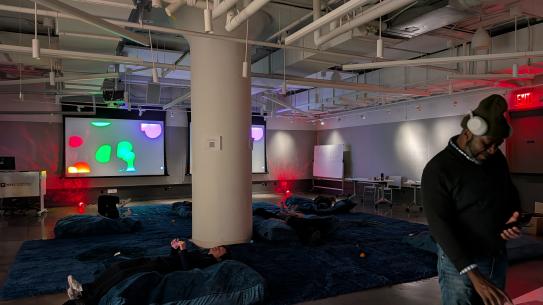When Left Meets Right: Poly Students Who Do It All

What happens when the imagination takes root and grows in different directions within the same person? Three NYU-Poly students—Wanda Molineros ’13BMS, Yangzi (Isabel) Tian ’13CBE, and Daphany Sanchez ’12SUE—are finding the balance and rewards of pursuing twin passions in both engineering and the arts.
The intersection of science and the arts is nothing new. Albert Einstein played the violin; composer Iannis Xenakis was also an architect-engineer who pioneered the use of mathematical models in music. And Leonardo Da Vinci… well, da Vinci did everything. In recent years, research has shown that studying the arts can significantly enhance cognitive ability in other areas.
“Many people don’t recognize the level of inventiveness necessary to imagine and design an experiment, test an interesting hypothesis, or to choreograph the steps involved in successfully completing an intricate experiment,” says Richard Wener of the Department of Technology, Culture and Psychology, who specializes in Environmental Psychology.
Melinda Parham, Director of Freshman Programs, agrees. “The arts and engineering and science are complementary in nature, as they are both concerned with the human condition, and the identification and creation of possible solutions to the problems born out of the process of living,” she says.
The Brightest Thing
In the chilly Biomolecular Science lab, Wanda Molineros examines specimens: tarantula, pigeon, and sheep brains. As an experienced TA, Molineros says, “Right now I’m doing pre-labs, going over and over each system.” She navigates the lab confidently in a crisp striped shirt and jeans; then, she unceremoniously pulls out a rectangle of poster board. “I’ve also been working on this.”
In the drawing, a girl in a crown emerges from graphite. Red-painted flowers dot the path at her feet. Molineros began sketching while working as a student assistant in the HEOP (Higher Education Opportunity Program) office during down time three years ago. Now she finds that no matter how busy she gets, she always comes back to her art. “It’s a stress-reliever,” she says. “I like using colored pencil, watercolor and I’m experimenting with oil.”
Born in Columbia, Molineros came to New York with her family at age six, eventually settling in Queens. In high school she focused on math, but freshman coursework at NYU-Poly inspired her to major in Biomolecular Science. “I was trying hard to go against my mother’s wishes [that I become] a doctor,” she says with a wide smile. “But I really liked biology.”
A self-taught artist, she says, “I do most of my art when I feel like saying something but can’t.” Like a still life of a lamp created during her mother’s cancer treatment, when things seemed dark: “I took the brightest thing in my room and drew it.”
Molineros can be somewhat reserved about her artistic side, but those who have worked with her praise her talent and drive. “This summer, Wanda thought of a great project of developing a digital anatomy and physiology learning apparatus,” says HEOP Director Shawneece Bailey. The new tool will allow students to move through an artist rendering of the human body, and Molineros is already creating illustrations of muscle groups for it using a digital drawing tablet.
Molineros characterizes her perspectives as both artist and scientist as “two different lenses” through which she sees the world, with some crossover. “If I can connect the subject artistically in my mind, it enables me to remember it, [and] being a scientist enhances the way I express myself through art, because I can visualize how organisms work through their metabolic states,” she says.
She smiles at the prospect of braiding science with art: “It’s pretty cool to be able to do both.”
A Language That Everyone Understands
Growing up in China, Yangzi (Isabel) Tian performed in children’s TV shows, studied opera, and hosted a school radio program. Then, when she was 13, her family moved to California, and the language barrier put her creative pursuits on hiatus.
 One day at her new school, when a friend was teased and Tian didn’t have words to defend her, she decided to master English. “I joined the drama club,” she says. “I learned Shakespeare. I watched The Sound of Music at least 50 times.” She also finished a three-year English Language Development program in one year. She says that she first learned the word ‘engineering’ from watching the Discovery Channel.
One day at her new school, when a friend was teased and Tian didn’t have words to defend her, she decided to master English. “I joined the drama club,” she says. “I learned Shakespeare. I watched The Sound of Music at least 50 times.” She also finished a three-year English Language Development program in one year. She says that she first learned the word ‘engineering’ from watching the Discovery Channel.
When a massive earthquake struck the Sichuan province of Tian’s native China, and the media reported on children who lost limbs in collapsed schools, a teacher mentioned the medical revolutions that might be achieved through stem cell research. “I couldn’t believe this way of generating all different parts of the body,” says Tian, a jade bracelet sliding on her wrist as she gestures excitedly. “The potential is amazing.”
Like Molineros, Tian watched her mother undergo painful cancer treatments. Now a Chemical and Biological Engineering major, she wants to advance stem cell use in cancer therapies. Her “AntiCancer” project placed third in NYU-Poly’s Inno/Vention Competition; this past summer, she worked at City of Hope University in California under Dr. Karen Aboody, who studies neural stem cell use in treating brain tumors.
Although a glance at her online calendar shows a fully booked schedule, Tian has returned to acting and singing through her presidency of NYU-Poly’s performing arts club. Also an avid artist, she draws both portraits and scientific illustrations, which she includes in presentations of her work, like the blood vessel she drew during research at Auburn University in Alabama last year. “Isabel is an incredible artist and an excellent researcher,” says Dr. Elizabeth Lipke, who supervised Tian there. “By combining her passions, [she] has the unique ability to communicate research in a language that everyone understands.”
Tian credits her engineering pursuits with giving her artistic talents new purpose. “Before, I was drawing for aesthetic reasons,” she says. “Now, I see a need for artistic representation in my field. I think we need more interaction between art and science—it’s these kind of combinations that can help to generate the most innovative ideas.”
Her Own Rhythm
Born and raised in Greenpoint, Brooklyn, Daphany Sanchez credits her Costa Rican, Puerto Rican, and Spanish family with fueling her love of dance. “Everyone expects my family to be very serious, because my mom is a political activist and my dad is a federal officer,” Sanchez says. “But my dad also DJs. Spanish dancing like Salsa or Bachata or Merengue is something you grow up with.”
A lifelong dancer, Sanchez co-founded a dance club, Global Fusion, when she transferred to NYU-Poly as a sophomore to study Sustainable Urban Environments.
“This is an engineering school,” she says, “But we encourage students of all backgrounds to come, even if you have two left feet.” Sanchez herself has both feet in the right places. In a video of the dance club’s campus flash mob last Halloween, she stomps and shimmies to Michael Jackson’s “Thriller” with innate grace and obvious pleasure. Global Fusion is another home for Sanchez. The group meets each week to unwind and learn new techniques, from classical Chinese to Indian Bhangra. “Students step in here, take off their shoes and stretch,” she says. “It’s a little safe haven.”
For Sanchez, engineering and dancing represent different ways to flex her creativity. “When I’m dancing, I’m listening to the music [and] I add my own style based on the rhythm that I hear,” she says. “It’s the same with my major—you have to listen and be creative and think outside the box to come up with green initiatives and designs.” On some fundamental level, she says, art and engineering are one and the same: “There’s a science in everything.”
Wener, who instructed Sanchez, says, “It is easy to imagine Daphany with a career where she takes on serious challenges, but impossible to imagine her taking them on in an ordinary or mundane way and without a bit of a twinkle in her eye.”
Not Going To Stop
All three students are excited about the future. Molineros is looking into grad schools and careers in the medical field, while Tian plans to earn a Ph.D. in Tissue Engineering with a focus on stem cell research. Sanchez will graduate in December and hopes to go straight into her Masters studies in Urban Infrastructure Management and Engineering.
Will they make time to keep growing as artists as they advance in science and engineering careers? Molineros seems to speak for all three when she smiles and says: “I don’t think it’s something that’s going to stop.”



